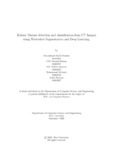Kidney Disease detection and classification from CT Images using Watershed Segmentation and Deep Learning.
Date
2022-09Publisher
Brac UniversityAuthor
Hossain, Mohammad SakibHassan, S.M. Nazmul
rahaman, Md. Nakib
Al-Amin, Mohammad
Hossain, Rakib
Metadata
Show full item recordAbstract
Chronic kidney disease, often called chronic kidney failure, is a steady decline of
renal function. Some of the most common reasons for kidney failure are cyst,
stone and tumor. There may be no symptoms of chronic renal disease in its first
stages. However, It’s possible to have kidney disease and not know it until it’s
too late. Fortunately various neural networks have been shown to be beneficial in
early disease prediction as machine learning and computer science has progressed.
In this paper, we have used 5 CNN classification methods that are based on wa tershed segmentation and make use of deep neural networks (DNN) to classify 4
types (cyst,normal,stone,tumor) of kidney CT images. There are two stages to our
work. We have first segmented the region of choice in CT images by watershed algo rithm. The segmented kidney data was then used to train a variety of classification
networks, which includes EAnet and the transfer learning based pre-trained neu ral networks: ResNet50, VGG19, InceptionV3, and SqueezeNet. Our models were
trained using the CT Kidney Normal Cyst Tumor and Stone dataset that was made
public on Kaggle. Finally, EANet, SqueezeNet, VGG19, InceptionV3, and ResNet50
achieved 83.6%,97.3%,99.9%,98.8% and 87.9% of accuracy, respectively, on the test
set of classification models. We observed that the modified VGG19 model had the
highest sensitivity and specificity as well as the best overall accuracy.

